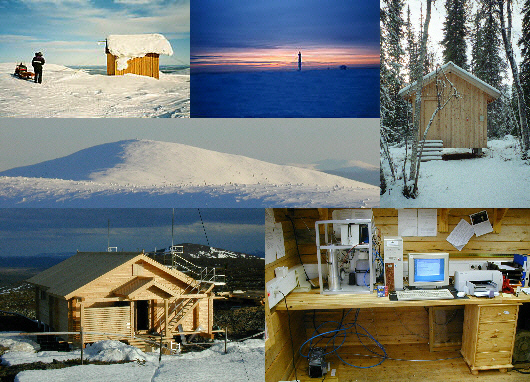[maxlat=77.0;minlat=57;maxlon=20;minlon=30;maptype=G_SATELLITE_MAP;zoom=6]
- Coordinates: 68°00’N, 24°14’E
- Height: 10 m
- Base level: 315 m ASL
- Country: Finland
- InGOS observations: CH4, N2O,SF6,Radon
- Responsible partner: FMI
- Responsible PI: (Tuomas.Laurila@fmi.fi)
- TNA access request page for Pallas
- Website:http://fmigaw.fmi.fi/

Pallas impressions (picture designed by Paula Sankelo)
General
Finnish Meteorological Institute (FMI) Pallas-Sodankylä WMO GAW-site in Finnish Lapland comprises of two infrastructures: Arctic Research Centre at Sodankylä (FMI-ARC) and the clean air site at Pallas 150 km NW of Sodankylä. The former site has a long history dating back to the first geophysical year in 1882/83. The clean air site at Pallas was established in the beginning of 1990’s and in 1994 the two sites were officially combined to form a major site in the World Meteorological Organization (WMO) coordinated Global Atmosphere Watch-program, officially known as Pallas-Sodankylä GAW site. The roles of the two sites are (roughly) such that surface measurements of GHGs, Aerosols and other background chemistry compounds are done at Pallas and GHG-, Ozone, and NO2 total columns, upper air soundings, and radiation measurements in Sodankylä. Both sites are equipped with meteorological towers which enable the flux measurements of heat, momentum, water vapour, CO2, and aerosol particles in a boreal spruce (Pallas) or pine (Sodankylä) forest. In Pallas, CO2, CH4 and N2O fluxes are measured on a near-by wetland. For characterization of surface properties Sodankylä has in situ surface, snow and soil measurements that are complemented by static tower spectrometer for surface reflectance from UV to Near IR as well as a tower MW radiometer and a MW radar (scatterometer). Total column GHG concentrations are measured by TCCON FTIR spectrometer. It is used also to validate Japanese GOSAT and in the future OCO-2 satellite observations. Early 2011, we will start atmospheric concentration measurements of CO2 and CH4 and a gas cylinder filling station.
Pallas node of the twin site operates several field sites at different environments The main locations for monitoring the tropospheric air composition are at Sammaltunturi mountain top site and at Matorova. The monitoring programme includes CO2, N2O, CH4, SF6, NOx, O3, CO, SO2, light hydrocarbons, black carbon, PM10, radon-222, aerosol particle number concentration and size distribution, aerosol scattering coefficient, main inorganic ions (e.g. SO42-and NH4+), persistent organic pollutants (POP) and heavy metals in the air and in precipitation, electrical conductivity and ionisation rate of the air, and surface weather parameters. At Kenttärova boreal spruce forest we measure fluxes of heat, momentum, water vapour, and CO2. At Lompolojänkkä wetland (northern aapa mire) we measure methane, CO2 and water vapour fluxes using eddy covariance technique.
Access
Access is provided to the measurement systems, accommodation, office and telecommunication facilities are available to users. The overall ensemble is used annually by around 50-100 international users.
Visits are usually of a short duration either campaigns, installation trips or utilization of local archives of data and meta information. Since the visits usually relate to the core functions of the Pallas-Sodankylä there is a host group where the visitors, so willing, can integrate themselves during the access period. Hence he/she has the same possibilities to technical and logistical support as regular personnel.
